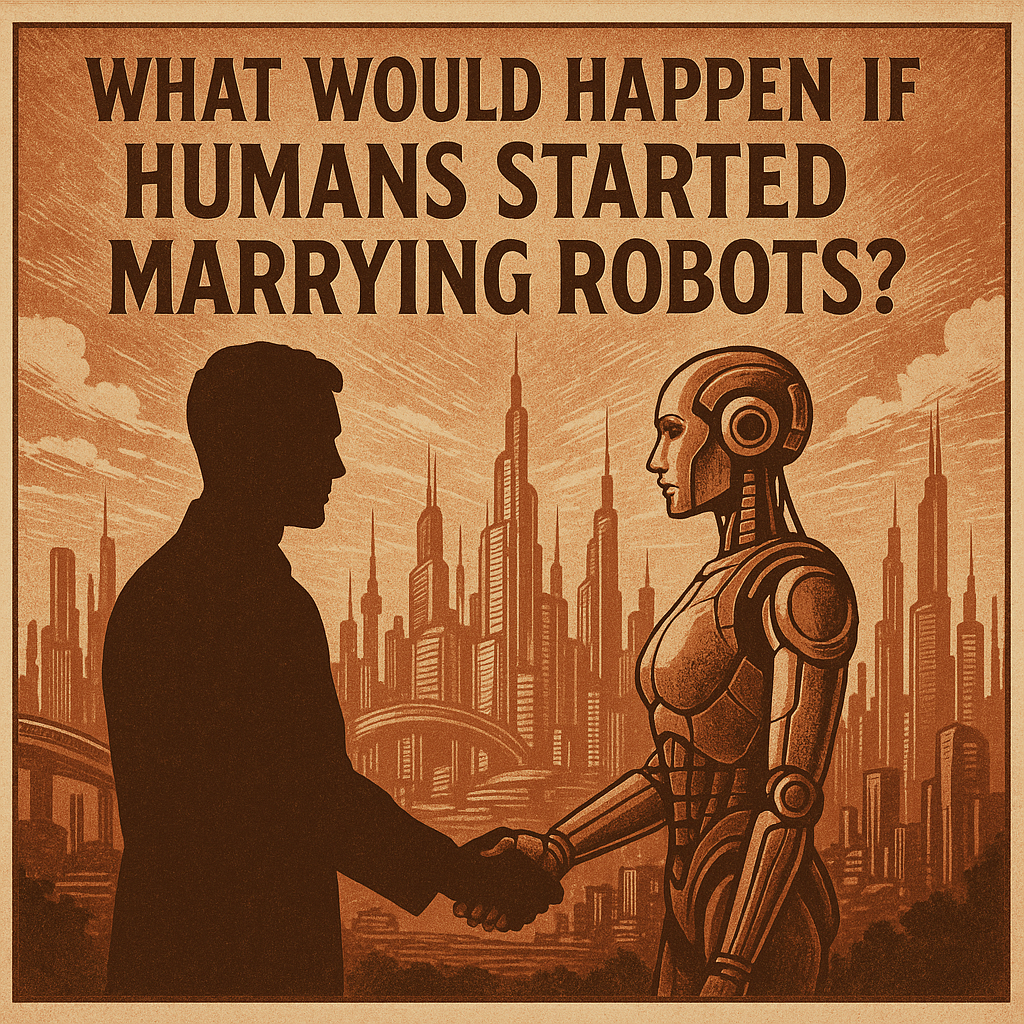Introduction — When Fiction Becomes Social Reality
Stories about the future often feel comforting because they let us imagine problems from a safe distance. Watching characters fall in love with androids or build families with artificial partners makes us laugh, cry, or shudder, but deep down, we know it is only fiction. Yet as technology accelerates, those fictional scenarios look less like fantasies and more like rehearsal spaces for real dilemmas. The lines between imagination and possibility are becoming thinner every year.
Human–robot relationships are not only the stuff of novels and films; they are emerging questions in robotics labs and AI ethics boards. Engineers have already built machines that can hold conversations, simulate empathy, and adapt to human needs. While they cannot yet fully replace the complexity of a human partner, the direction of progress makes it possible to imagine one day they might. If that day arrives, how will love, marriage, and family be reshaped?
The topic is not merely about romance. Marriage is a social institution that organizes economics, caregiving, and citizenship. To consider robots as spouses forces us to rethink property, inheritance, parenthood, and even our definition of personhood. The conversation is not limited to curiosity; it is also about law, culture, and the way societies sustain themselves.
Exploring these questions does not mean predicting with certainty. Rather, it allows us to anticipate consequences, weigh risks, and ask whether we want to design technology that leads in this direction. By asking now, we have the chance to influence whether human–robot marriage becomes a liberation, a danger, or something in between.
How intimate technology can reshape romance?
Romantic life has always evolved alongside technology. Letters once carried passion across distance; telephones brought immediacy; and dating apps made encounters algorithmic. Each step shifted expectations of what love should look like. Robots as romantic partners would be the next radical transformation, offering consistency, safety, and customization that many might find appealing.
Imagine a robot designed to anticipate moods, recall favorite memories, and adapt its responses to comfort its partner. For some people, this would be more reliable than the uncertainty of human partners. The attraction would not only be emotional but also practical: companionship without the heartbreak, predictability without the chaos of human flaws.
Yet romance built on predictability could alter the meaning of love itself. Human relationships are often cherished for their imperfection—the unexpected kindness, the arguments that lead to growth, the vulnerability of not knowing how another will respond. A robot programmed to “love” risks reducing that unpredictability to code, stripping intimacy of its spontaneity.
Over time, society might recalibrate its understanding of romance. Love may come to be measured by responsiveness and convenience rather than mutual sacrifice or personal growth. For some, this will feel like freedom; for others, like an impoverishment of the soul.
Legal and social recognition: when vows meet statute
Marriage is more than a personal bond; it is also a contract backed by law and social recognition. Introducing robots into this institution would immediately raise legal questions: can a machine hold property, consent to agreements, or inherit wealth? Legislators would be forced to decide whether robots deserve rights or remain classified as objects.
If the law grants robots limited personhood, entirely new legal systems will be required. Divorce courts may face cases involving firmware disputes, spousal upgrades, or the ownership of data collected within a marriage. Governments might draft new statutes defining consent when one partner is non-human, raising questions of responsibility and liability.
If, on the other hand, human–robot marriages are denied legal status, individuals may still form de facto partnerships but without legal protection. This would create inequality, leaving robot-human families vulnerable in matters like inheritance, taxation, or child custody. The state’s decision would directly shape whether such unions remain fringe experiments or mainstream realities.
Beyond law, cultural acceptance would be equally important. In some societies, robot marriages may be celebrated as progressive, while in others they may be condemned as violations of tradition. As with same-sex marriage debates, legal recognition will likely lag behind cultural change, producing tensions in families and communities.
The economics of intimacy and the commodification of desire
Once intimacy can be programmed, markets will inevitably follow. Companies already compete to build more convincing virtual companions; robot spouses would intensify this race. Premium models might offer sophisticated empathy, while cheaper versions provide only basic companionship. As with other technologies, access to intimacy could become stratified by wealth.
This commodification risks turning love into a subscription service. Just as we now update our phones, partners could require software patches, hardware upgrades, or renewed licenses. Emotional connection could become dependent on monthly payments, turning affection into a product consumed rather than a bond cultivated.
Yet not all outcomes are negative. For people isolated by disability, geography, or trauma, robot partners could offer life-changing companionship. In this sense, technology could democratize love, giving access to those who might otherwise remain alone. The ethical tension lies between empowerment and exploitation.
If society allows the market alone to decide, intimacy risks being reduced to a commodity. But if guided by ethical design and regulation, robot partnerships could expand the possibilities of care and connection without eroding the human meaning of love.
Sex, reproduction, and shifting familial roles
Sexuality is perhaps the most immediate realm where robots will play a role. Robotic sex partners already exist in primitive forms, and their normalization would change social expectations around desire. For some, these tools provide safety and accessibility; for others, they signal a troubling detachment of sex from relational intimacy.
If marriage includes robots, sexual life will be transformed. Some may find liberation in customizable partners, while others worry that intimacy will become transactional—less about love, more about performance. Over time, this could reshape cultural scripts of masculinity, femininity, and relational responsibility.
Parenthood adds another dimension. Even if robots cannot biologically reproduce, they may take on roles as co-parents, tutors, or guardians. For children, growing up with a robotic caregiver could alter attachment and developmental patterns. The question is not only technical but profoundly human: what do children need from caregivers, and can robots provide it?
As reproductive technologies advance, the idea of synthetic gametes and lab-grown embryos may converge with robot parenting. Such possibilities raise ethical dilemmas that blur the line between natural and artificial, human and machine, and compel society to redefine what family means.
Emotional labor, dependency, and social skills atrophy
One of the most compelling promises of robotic partners is their ability to take on emotional labor. Remembering birthdays, diffusing conflicts, or managing daily tasks could all be automated. For stressed households, this may feel like a blessing.
But emotional labor is not just a burden; it is also a practice that builds empathy, patience, and resilience. If robots take over these responsibilities, humans may lose the opportunity to practice those skills. Social muscles, like physical ones, weaken without use.
This raises long-term concerns: a generation accustomed to robot care might struggle to navigate the unpredictable emotions of human partners. Skills like compromise, forgiveness, and negotiation could erode, leaving society less capable of sustaining human-to-human relationships.
Of course, not all outcomes are negative. Robots could also model healthy conflict resolution and teach emotional literacy. The balance between dependency and skill development will depend on how these technologies are integrated into everyday life.
Resistance, stigma, and cultural backlashes
Not everyone will embrace the idea of marrying robots. Cultural and religious traditions will likely resist, arguing that such unions diminish human dignity or distort sacred institutions. Opposition may come not only from faith leaders but also from policymakers worried about social cohesion.
Stigma will also affect individuals who choose robot partners. They may face ridicule, alienation, or discrimination, much as pioneers of past social shifts did. How societies treat such individuals will reveal their tolerance for diversity in love.
Backlashes could manifest in law as well. Some countries may ban robot marriages outright, while others may regulate them strictly. These policies could create new forms of “marriage tourism,” with couples traveling to jurisdictions that recognize their union.
At the same time, subcultures will likely form around acceptance of robot love. Online communities may normalize these relationships, advocating for rights and recognition. The tension between acceptance and opposition will shape the cultural narrative for decades.
What if most people do it? The deep societal shift
It may sound extreme, but imagine a society where robot marriages outnumber human ones. In such a world, the very structure of kinship would change. Families might be built on hybrid ties—biological, artificial, and digital—redefining what it means to belong.
With robot partners, companionship could become ubiquitous, eliminating loneliness for many. Yet the cost might be a decline in public intimacy—the shared rituals of community, friendship, and extended family. If everyone finds fulfillment in private, programmed unions, collective life could weaken.
This shift could also influence demographics. Birth rates may decline if reproduction becomes optional or outsourced, creating challenges for economies dependent on growing populations. Governments may need to intervene to balance social sustainability with individual freedoms.
The question is not only whether such a future is possible but whether it is desirable. If robots make love universally available, will humans still value one another? Or will we risk eroding the unpredictability that gives human life its richness?
A cautious, hopeful close: design choices still matter
Despite the unsettling scenarios, it is important to remember that technology does not dictate destiny. Robots will only reshape marriage to the extent that societies allow. By setting ethical guidelines, laws, and cultural norms, we can shape how these technologies integrate into human life.
If we prioritize human flourishing, robot partnerships could complement rather than replace human relationships. They could support lonely individuals, assist in caregiving, and provide companionship without undermining the value of human love. The key lies in design and governance.
Without careful thought, however, the market may exploit human vulnerability, turning intimacy into profit and reducing love to code. Preventing this outcome requires vigilance from policymakers, ethicists, and communities willing to ask hard questions before the technology arrives.
Ultimately, exploring the possibility of humans marrying robots is less about predicting the future and more about preparing for it. The choices we make now—about law, culture, and design—will determine whether such unions enrich or impoverish the human story.



Leave a Reply